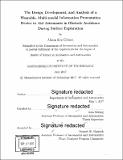The Design, development, and analysis of a wearable, multi-modal information presentation device to aid astronauts in obstacle avoidance during surface exploration
Author(s)
Gibson, Alison Eve
DownloadFull printable version (22.39Mb)
Other Contributors
Massachusetts Institute of Technology. Department of Aeronautics and Astronautics.
Advisor
Leia Stirling.
Terms of use
Metadata
Show full item recordAbstract
The future of human space exploration will involve extra-vehicular activities (EVA) on foreign planetary surfaces (i.e. Mars), an activity that will have significantly different characteristics than exploration scenarios on Earth. These activities become challenging due to restricted vision and limitations placed on sensory feedback from altered gravity and the space suit. The use of a bulky, pressurized EVA suit perceptually disconnects human explorers from the hostile environment, increasing navigation workload and risk of collision associated with traversing through unfamiliar terrain. Due to the hazardous nature of this work, there is a critical need to design interfaces for optimizing task performance and minimizing risks; in particular, an information presentation device that can aid in obstacle avoidance during surface exploration and way-finding. Multi-modal displays are being considered as cues to multiple sensory modalities enhance cognitive processing through taking advantage of multiple sensory resources, and are believed to communicate risk more efficiently than unimodal cues. This thesis presents a wearable multi-modal interface system to examine human performance when visual, vibratory, and visual-vibratory cues are provided to aid in ground obstacle avoidance. The wearable system applies vibrotactile cues to the feet and visual cues through augmented reality glasses to convey obstacle location and proximity. An analysis of obstacle avoidance performance with the multi-modal device was performed with human subjects in a motion capture space. Metrics included completion time, subjective workload, head-down time, collisions, as well as gait parameters. The primary measures of performance were collision frequency and head-down time, as these both must be minimized in an operational environment. Results indicate that information displays enhance task performance, with the visual-only display promoting the least head-down time over tactile-only or visual-tactile displays. Head-down time was the highest for trials without a display. Results provide implications for presenting information during physically active tasks such as suited obstacle avoidance.
Description
Thesis: S.M., Massachusetts Institute of Technology, Department of Aeronautics and Astronautics, 2017. Cataloged from PDF version of thesis. Includes bibliographical references (pages 149-158).
Date issued
2017Department
Massachusetts Institute of Technology. Department of Aeronautics and AstronauticsPublisher
Massachusetts Institute of Technology
Keywords
Aeronautics and Astronautics.